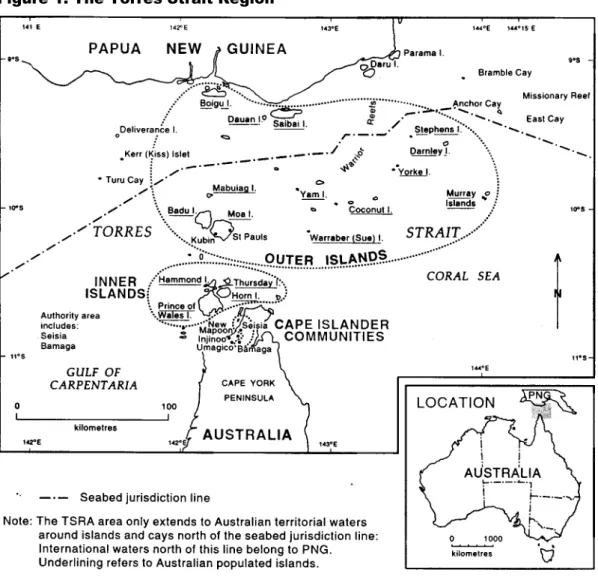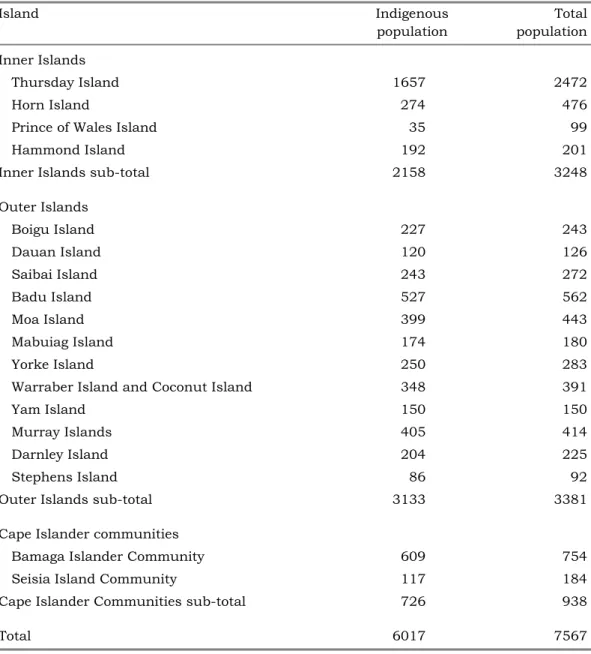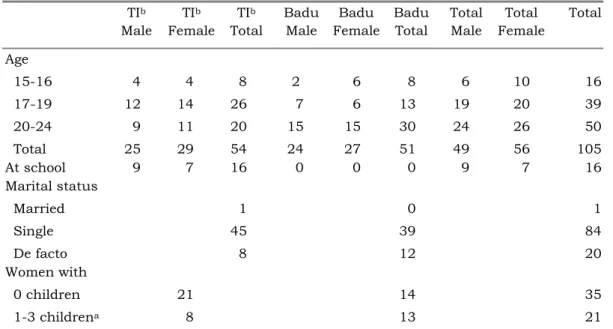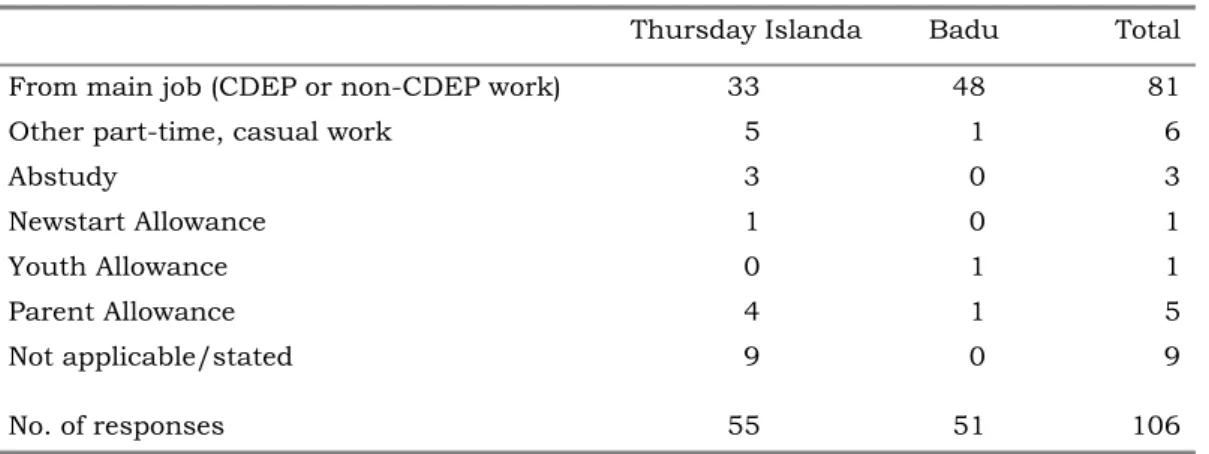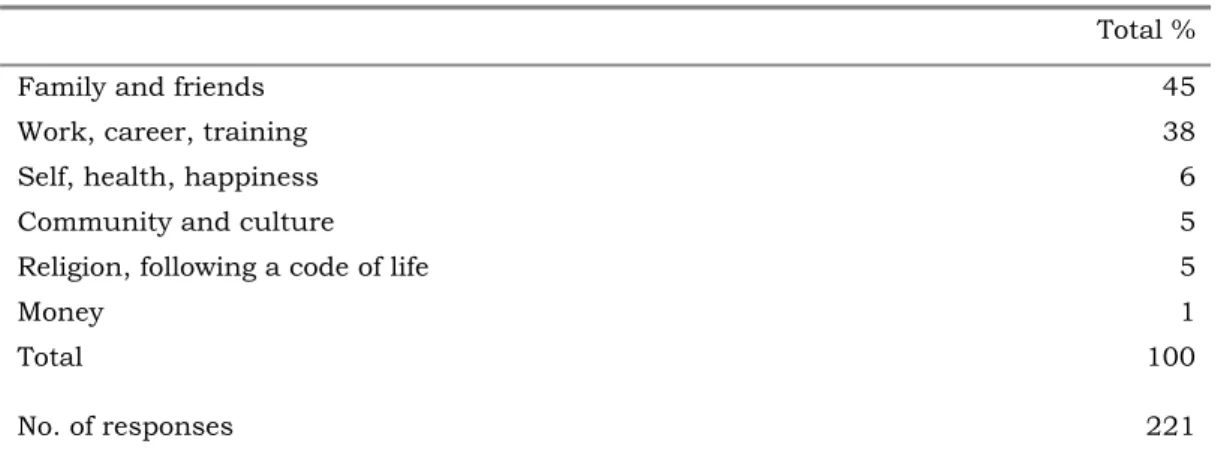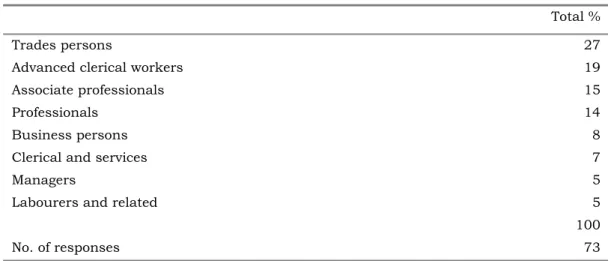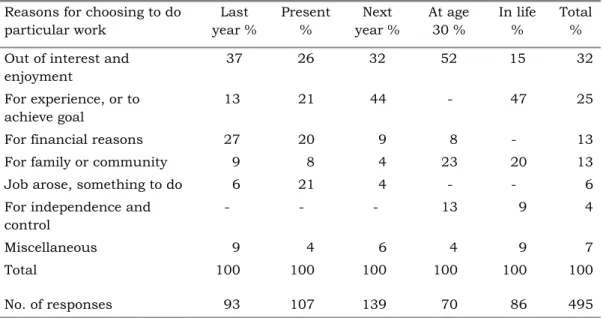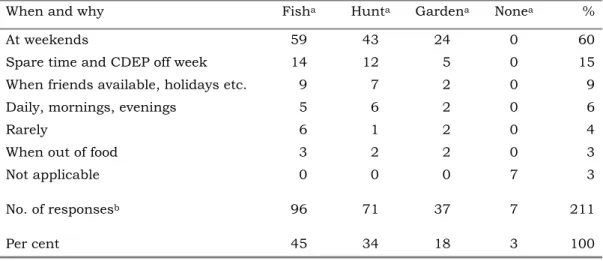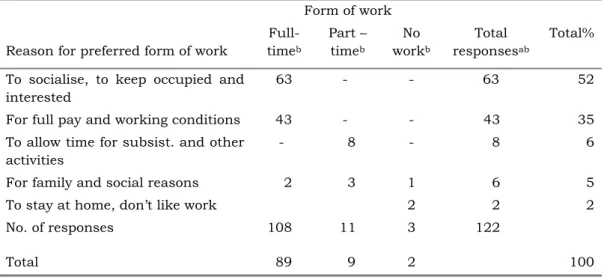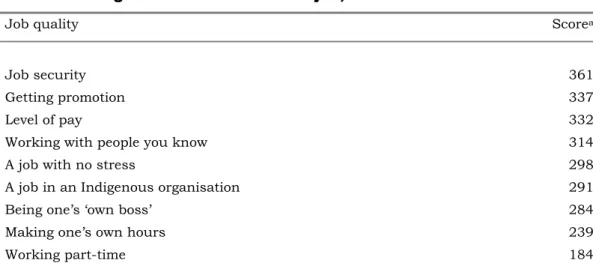Career aspirations and orientation to work:
Young Torres Strait Islanders, 1999 W.S. Arthur and J. David-Petero
No. 206/2000
ISSN 1036-1774 ISBN 0 7315 2641 4
Mr Bill Arthur is Research Fellow at the Centre for Aboriginal Economic Policy Research, The Australian National University and Ms Josephine David-Petero is a member of the Hammond Island Council in Torres Strait.
Foreword
In 1998, The Australian National University (on behalf of the Centre for Aboriginal Economic Policy Research (CAEPR)) and the Department of Family and Community Services (Indigenous Policy Unit (IPU)) signed a five-year research agreement. As part of this agreement, CAEPR and IPU negotiated to undertake research seeking to examine how the aspirations of young Indigenous people in remote regions match the Commonwealth government’s income support programs for the unemployed. The project aims to be longitudinal: it is scheduled to run over five years (1999 to 2003) and will consist largely of an analysis of data obtained from standard surveys of the same sample of Indigenous males and females aged between 15 and 24 in two remote locations, the Kimberley and Torres Strait. The study will attempt to reinterview the same cohort over the research period.
The initial survey was carried out Torres Strait in late 1999 and this paper is one of a set of three interrelated papers resulting from that work. The other two CAEPR Discussion Papers are numbers 205 and 207. These deal respectively with the job-searching and careers, and the education and training issues amongst young Torres Strait Islanders. These three papers are closely related and readers are encouraged to consider them holistically as a set.
The set of three discussion papers is based on a close collaboration between Bill Arthur, a CAEPR academic and Josephine David-Petero, a Torres Strait Islander, who is a member of the Hammond Island Council. Such collaboration is a very important element in CAEPR’s Indigenous Engagement Strategy. Additional collaboration also occurred, of course, between the two researchers and the young Torres Strait Islanders who greatly facilitated the research by their availability for interview: it is hoped that the policy outcomes of the research are of direct benefit to them.
These discussion papers address very important and topical issues very evident in key words in their titles: job-searching, careers, aspirations, orientation to work, education and training. This research is based on primary data collection in the Torres Strait and should be of invaluable benefit in policy formulation.
Professor Jon Altman Director, CAEPR December 2000
Table of Contents
Foreword... iii
Summary ...vi
Acknowledgments ...vii
Introduction... 1
Methodology and analysis... 1
Torres Strait and the sample... 2
Notions of career and orientation to work... 6
Careers and aspirations... 8
Preferred activity next year ... 8
Preferred activity when 30 years old ... 9
Preferred activity in life... 11
Identified career destinations ... 12
Subsistence and employment ... 13
Orientation to work... 13
Perceived preferred qualities for a job and for ‘work mates’... 15
Preferred form of work... 15
Preferred job qualities ... 15
Preferred ‘work mates’ ... 17
Income ... 19
Expenditures... 19
Conclusions... 20
Appendix A. Abridged questionnaire... 23
Appendix B... 26
References... 29
Tables
Table 1. Population of Torres Strait, 1996...3
Table 2. The composition of the sample, 1999 ...4
Table 3. Employment/education status, 1999 ...5
Table 4. Main source of income, 1999...6
Table 5. Preferred activity next year, 1999 ...10
Table 6. Preferred activity when 30 years old, 1999 ...10
Table 7. Preferred activity in life, 1999...11
Table 8. The most valued things in life, 1999...11
Table 9. Identified career destinations, 1999 ...13
Table 10. Extent and timing of subsistence activities, 1999 ...14
Table 11. Reasons for choosing to do particular work, 1999 ...14
Table 12. Preferred form of work, 1999...16
Table 13. Things seen as valuable in a job, 1999 ...17
Table 14. Job qualities described, 1999...17
Table 15. Preferred work mates, 1999 ...18
Table 16. Adequacy of income, 1999...19
Table 17. Estimated present and desired median fortnightly incomes, 1999...20
Table 18. Most significant weekly expenditures, 1999 ...20
Figure Figure 1. The Torres Strait Region ...2
Summary
The principal aim of this paper was to determine what views young Torres Strait Islanders had about their careers and to assess their orientation or approach to work. Young Torres Strait Islanders often express their view of their future in terms of their work. However, as noted elsewhere in the study commitments to career may have to be balanced with those to family.
People’s notions of career seem influenced by their surrounding social and economic environment. Many young women are keen to work in areas such as health and education while young men are often interested in related trades positions. Despite the fact that commercial fishing is the region’s primary industry, and that Islanders are already involved in this not one young person in the survey nominated this as their chosen career. Future stages of this longitudinal study will attempt to find out more about how young people view work in commercial fishing.
Cultural background may also influence people’s approach to work. For example, they value the opportunity to work with others who understand them and their culture or ‘Islander ways’ and express some attraction for working in an Islander organisation and/or with other Islanders. However, a high value is also placed on working with people who have skills and who can pass these on. An ideal work environment might be one which includes supervisors who are skilled in their profession or trade and in cross-cultural communication.
Young Islanders place a high value on work that is interesting, that helps them to achieve their career goals, that is reasonably paid, that provides promotion and that is secure. These findings suggest that, in some respects, indigenous people may approach work in a similar way to other young people.
Young Islanders are quite negative about the CDEP scheme and this often because they see the normal part-time CDEP work as relatively meaningless and boring. However, CDEP communities in the survey are able to create full-time positions, traineeships and apprenticeships within CDEP, and these options are valued by the participants. The CDEP scheme can also provide some of the more culturally specific work qualities that people value. It allows participants to work with people they know and can communicate with, and in a work environment in which they feel comfortable. Therefore, although many view the scheme negatively, it does appear to have the potential to provide some career pathways and in this regard, CDEP communities could be said to be operating rather like development agencies. A continuing challenge for community leaders and policy makers is to provide career options for young people within the CDEP environment.
As noted in the foreword, this is one of a set of three papers from an initial survey in Torres Strait. The other two papers in the set deal respectively with people’s careers and job searching techniques (CAEPR Discussion Paper No. 205) and with the relationship between their education and training, and their careers (CAEPR Discussion Paper No. 207). The initial survey that provided the data for this paper is part of a larger study. The study utilises the concept of career which facilitates an exploration of what people think about their future and embodies the idea of
change over time. The project aims to determine what may assist or deter people from fulfilling their aspirations, and how and why their ideas about their futures may change. In an attempt to capture these aspects of people’s lives, those who were part of this initial survey will be interviewed again.
Acknowledgments
We would like to thank the following people in Torres Strait for their assistance: members of the Tamwoy, Rose Hill, Aplin, Abednego, Waiben, Quarantine and Badu Community and Island Councils, the staff of Job Network on Thursday Island and on Badu Island, the Centrelink staff, the Principal and staff of Thursday Island State High School, and of course to all of those who gave their time to be interviewed. Special thanks must go to the CDEP and office staff of TRAWQ and of Badu Island for their help in making time and space available to interview their participants. Special thanks also to the Torres Strait Regional Employment Committee which provided invaluable office space, advice and support during the survey.
Thanks to Boyd Hunter and Will Sanders of the Centre for Aboriginal Economic Policy Research (CAEPR) for useful comments on this paper, to Hilary Bek, Frances Morphy and Linda Roach for their usual high standard of editorial input, and to Wendy Forster for layout.
Introduction
The Indigenous Policy Unit of the Department of Family and Community Services (DFACS)1 has negotiated with the Centre for Aboriginal Economic Research (CAEPR) to carry out research aimed at answering the following questions for the remote regions of Australia:
a) To what extent do the objectives of the 15 to 24 year-old Indigenous clients match the objectives of the Commonwealth Government’s programs related to income support for the unemployed?
b) What are the particular local conditions which might be limiting or affecting the program objectives?
c) In what ways might the programs be modified to make the objectives more compatible?
The project aims to be longitudinal: it is scheduled to run over five years (1999 to 2003) and will consist largely of an analysis of data obtained from standard surveys of a sample of Indigenous males and females aged between 15 and 24 in two remote locations, the Kimberley and Torres Strait. The study will follow this cohort over the period.
The questions posed above are aimed at assessing the relevance of programs and at proposing how they might be made more relevant. The particular programs under consideration are Newstart and Youth Allowance. The approach to the project has been to adopt the concepts of ‘career’ and ‘orientation to work’ which facilitatesan inquiry of what people want to do and why they want to do it (see Arthur 1999). This in turn allows an assessment of the relevance of the programs to people’s careers in remote areas.
This paper is based on the results of a survey of 105 young people in Torres Strait carried out in late 1999. The survey results have revealed information that is usefully divided into three major categories:
• Job searching and careers: young Torres Strait Islanders, 1999;
• Career aspirations and orientation to work: young Torres Strait Islanders, 1999; and
• Education, training, and careers: young Torres Strait Islanders, 1999.
This paper focuses on the second of these categories which deals with the view people have of their careers and on their orientation to work.
Methodology and analysis
Based on a sample of only just over 100 people, the survey is small and this places in doubt the conclusions that can be drawn from individual questions.
However, some general trends and patterns are shown in the paper.
Questions in the survey were generally left open rather than being multiple choice. This creates the difficulty of coding but it has the advantage that it allows people to give their own replies. This is in the spirit of the project which is
directed at finding out how young people perceive their future and the relevance of the government services. People were asked to answer all of the questions and the interviews were administered by the authors.
An abridged version of the questionnaire is included in Appendix A. Where applicable, a note is provided with each of the tables, indicating from which question or set of questions the results are derived.
Figure 1. The Torres Strait Region
Torres Strait and the sample
Torres Strait is an archipelago lying between the tip of Cape York and the Western Province of Papua New Guinea. Approximately 7,500 people live in Torres Strait2 of whom around 80 per cent are Indigenous. The two major industries are
commercial fishing and a public sector servicing the population. The region is often considered as made up of three sub-regions: the Inner Islands, the Outer Islands and the Cape Islander communities (Fig. 1). The islands and communities and their populations are shown by sub-region in Table 1. (For a full description of the region and the socioeconomic status of Torres Strait Islanders see Arthur 1999.)
Table 1. Population of Torres Strait, 1996
Island Indigenous population
Total population Inner Islands
Thursday Island 1657 2472
Horn Island 274 476
Prince of Wales Island 35 99
Hammond Island 192 201
Inner Islands sub-total 2158 3248
Outer Islands
Boigu Island 227 243
Dauan Island 120 126
Saibai Island 243 272
Badu Island 527 562
Moa Island 399 443
Mabuiag Island 174 180
Yorke Island 250 283
Warraber Island and Coconut Island 348 391
Yam Island 150 150
Murray Islands 405 414
Darnley Island 204 225
Stephens Island 86 92
Outer Islands sub-total 3133 3381
Cape Islander communities
Bamaga Islander Community 609 754
Seisia Island Community 117 184
Cape Islander Communities sub-total 726 938
Total 6017 7567
Source: From Sanders (1999a).
The Torres Strait sample was split equally between males and females (Table 2) and between two locations in Torres Strait. These were the regional centre of Thursday Island located in Inner Islands, and on Badu Island which is one of the Outer Islands. These are akin to a regional town or service centre on the mainland and a remote Indigenous community. These two locations have very different socioeconomic environments (Arthur 1999). In brief, Thursday Island has a recognised labour market as well as a medium-sized Community Development Employment Projects (CDEP) scheme, while Badu has virtually no labour market and a significant CDEP scheme under the control of an island community council.3 The area offices of Centrelink and Job Network are on Thursday Island. On Badu there is a community agent of Centrelink and a Job Network agency was being established only during the survey. The respective area offices for both agencies are on Thursday Island.
Taking the 1996 Census as a base, the sample represents 17 per cent of Indigenous people aged 15 to 24 years on Thursday Island, 70 per cent of those on Badu, and 10 per cent of those in all of the Torres Strait. Where relevant and where the data allow, the analysis provided here describe males and females separately and Thursday Island and Badu separately. However, because the sample is small (105 people) and not all people responded to all of the survey questions, this procedure is not always possible or valid in the tables.
Of the sample on Thursday Island, 16 were still at school there. Only one of the sample was married, 84 were single and the remaining 20 were in de facto relationships. More than one-third of the women in the sample had children.
It is unclear how representative the sample is. More than half of those not in school were involved in CDEP in some way while only three of the sample were unemployed (Table 3). Centrelink on Thursday Island were unable to give an accurate assessment of the number of people on Newstart Allowance on Thursday Island. However their estimate ranged from five to ten people. If this is the case, then the sample may not be too unrepresentative. Only two people in the sample gave their main source of income as Newstart or Youth Allowances, while almost half (48 people) were part of a CDEP scheme (Table 4). This accords with other data provided below and indicates that labour market oriented payments (Newstart and Youth Allowances) are relatively insignificant in the lives of people aged 15 to 24 years, and that CDEP is extremely significant.
Table 2. The composition of the sample, 1999
TIb
Male TIb Female
TIb Total
Badu Male
Badu Female
Badu Total
Total Male
Total Female
Total
Age
15-16 4 4 8 2 6 8 6 10 16 17-19 12 14 26 7 6 13 19 20 39 20-24 9 11 20 15 15 30 24 26 50 Total 25 29 54 24 27 51 49 56 105 At school 9 7 16 0 0 0 9 7 16
Marital status
Married 1 0 1
Single 45 39 84
De facto 8 12 20
Women with
0 children 21 14 35
1-3 childrena 8 13 21
Notes: a. Pregnant women were counted as having one child.
b. TI = Thursday Island.
Source: Derived from question 1, see Appendix A.
Table 3. Employment/education status, 1999
Total
Employed CDEP 48
Employed non-CDEP 36
Voluntary workers 2
Unemployed 3
School 16
Total number 105
Source: Derived from questions 17 and 46, and 47 see Appendix A.
Table 4. Main source of income, 1999
Thursday Islanda Badu Total
From main job (CDEP or non-CDEP work) 33 48 81
Other part-time, casual work 5 1 6
Abstudy 3 0 3
Newstart Allowance 1 0 1
Youth Allowance 0 1 1
Parent Allowance 4 1 5
Not applicable/stated 9 0 9
No. of responses 55 51 106
Note: Includes those at school on Thursday Island.
Source: Derived from questions 42, 46 and 47, see Appendix A.
Notions of career and orientation to work
As this project is about assessing people’s objectives with relation to labour market type programs it can be informed by a consideration of the two related notions of ‘career’ and ‘orientation to work’ (Arthur 1999). The concept of career encompasses the relationship between people and their work over time (Arthur et al 1989: 8, 12). This relationship usually, though not always, includes the notion of change and/or advancement along a path or course (Dalton 1989: 89, 94:
Nicholson and West 1989: 181). It has been suggested that careers can take several different forms. These include the ‘linear career’ in which a person may select a field early in life and then progress upward from a lower to a higher status position (a path commonly followed by managers); the ‘steady state career’
where the individual selects a job or field of work early in life and stays in that for all of their working life (professionals such as doctors and dentists, or skilled tradespeople are typical here); or the ‘transitory career’ where the individual moves from job to job without any particular pattern being established (Arthur 1999; Dalton 1989: 94). In this way we can suggest that anyone who works has a career (Arthur et al. 1989: 8).
There are differing views about what might influence people to follow one career path over another. One view is that careers are a matter of individual choice and initiative, another is that careers are very much shaped by people’s social and economic milieu and that it is the demands of society and the availability of options which ultimately determine people’s careers (Arthur et al. 1989: 12; Bell and Staw 1989: 232–4; Dalton 1989: 91; Derr and Laurent 1989: 454; Thomas and Aldefer 1989: 357; Watson 1995: 132). Family values, class background, and societal values or culture can also influence career choices (Derr and Laurent 1989: 465). For example, it has been suggested that in cultures which value family and personal relationships, people will avoid stressful careers which might
jeopardise these relationships (Watson 1995: 146). In any event, the concept of career includes the idea that the relationship between people and their work may change over time, and so it has some relevance to this project which follows a cohort of young people over a five year period (Arthur 1999).
For many people in the modern era, work is seen as fulfilling a number of positive functions and needs beyond earning a living. For instance, it gives a sense of purpose; creates social contacts outside the home; it can provide identity and social status; and it gives structure to one’s day (Evans and Poole 1991; Sayers 1988; Watson 1995: 165). Importantly for most, work and participation in the labour market is also the principal means of deriving a reasonable level of income (Thomas and Aldefer 1989: 358; Watson 1995: 165). As work has the ability to fulfil the above needs, then these needs can remain largely unmet when people are without work, with the failure to find work resulting dissatisfaction and alienation from society (Evans and Poole 1991; Sayers 1988: 731; Watson 1995:
165).4 People’s orientation to work, like their approach to their career, stems from a combination of factors. Some of these relate to their personal background such as family class, gender and race, and ethnic background as well as to external factors such as the structure of the prevailing job market (Watson 1995: 133–4).
It is important to note that in this discussion, work is equated with employment and, therefore, it is implied that through employment certain needs are met. This requires some qualification. In the Indigenous milieu people may expend a significant amount of effort on subsistence activities, ceremonial activities, art, and community voluntary work (see Altman 1987; Altman et al. 1997; Australian Bureau of Statistics and Centre for Aboriginal Economic policy Research 1997;
Arthur 1990). For example, in Torres Strait people may judge their life successful in terms of their skills in dancing, participation in Island politics, and turtle hunting (Arthur 1999; Bird and Bird 1997: 70). These activities represent work but not always employment. On the other hand, some people (as we shall see below) may perform these and other activities when they are participants in the CDEP scheme. Employment includes the notion of a contract, more or less explicit, between an employee and employer (Watson 1995: 139) and in the CDEP scheme the contract is made between the participants and their community.
Therefore, subsistence and other activities carried out by participants of a CDEP scheme could be classified as a form of employment. In any event, these kinds of activities, whether carried out within the CDEP scheme or not, can help fulfil cultural and economic needs. This alerts us to the idea that people’s needs may be met by activities or work outside the world of employment. Indeed, it is a recognised fact that while employment may fulfil certain needs, other activities outside employment often provide people with their major satisfaction in life (Sayers 1998: 729, 730; Watson 1995: 118, 144, 163).
It should also be noted that, while the general view is that work fulfils a number of needs and so seen relatively positively by society, this has not always been the case: the ancient Greeks and the pre-industrial Europeans viewed work negatively (Berger 1963: 25; Sayers 1988: 734). Research has indicated that hunters and gatherers strived to reduce their work effort and that even today
surveys carried out in Europe indicate that, if given the option, some people would rather reduce their working hours than increase their incomes (Sayers 1988: 733, 736).
As people’s views of their career may change over time and in response to changing circumstances, so might their orientation to work (Watson 1995: 121, 123). These two concepts are therefore used to help inform this longitudinal research project. The aim of this paper is to determine whether young Torres Strait Islanders have a view about their careers and if so, what this might be, and to assess their orientation to work. People’s view of their career is explored by asking them what they wish to do in the future. Their orientation to work is explored by asking them why they wish to do these things, and by asking them what qualities they value in work (see Appendix A).
Careers and aspirations
Three sets of questions in the survey were directed at finding out what people wanted to do in the future. They were asked what they would like to be doing in one year’s time, by the time they were 30 years old and what they would most like to do in life (see questions 24, 34, and 54 in Appendix A). The answers to these questions gave a similar pattern in as much as people constantly indicated that their career or job was important to them. However, the emphasis given to this was different in the long and short term. In addition, people found it easier to describe their short-term than their long-term aspirations. This mirrors findings for the general population where it has been noted that young people tend to view the world no further than five years ahead (Poole and Cooney 1987).
Preferred activity next year
Referring to Table 5, 45 per cent of all people said they wanted to be in a better job, the kind of job that they liked, or in a full-time job. Being in a full-time job was the equivalent of being in a better job as will be explained in a later section of this paper. Also, as in the non-Indigenous population, better jobs appear to be those which are skilled or involve office work (Wilson and Wyn 1987). The aim to be in a better job was common in both Thursday Island and Badu. However, the aim to be in a full-time job was more pronounced on Badu. This possibly reflects the predominance of CDEP on Badu and the dissatisfaction people feel with the part-time nature of most CDEP work (see Arthur 2000a). CDEP is basically a form of ‘work for the dole’ and as people are normally paid at an award rate, they need only work part-time. This feature is managed in different ways across the various CDEP schemes. In Torres Strait, the arrangement is for people to work on a week- on/week-off basis. This type of work is termed here as ‘CDEP general’. Another form of CDEP work is full-time and/or includes a recognised training element. In this, the full-time wage is met from a combination of CDEP and other sources.
For example, the cost of teacher aides and administrative assistants in the school was shared by the CDEP and the school. Apprenticeships and traineeships were similarly cross-subsidised. People value this kind of CDEP work; they find it interesting and the full-time work provides them with higher pay. Also, the work
(including in the council administration) and the apprenticeships are perceived by some as pathways to other job opportunities. It was noticeable that no one in the survey who was on CDEP general said they wanted to be on this in a year’s time.
Further, only those people who were in full-time work said they wanted to be in the same job the following year (11% in Table 5). In their analysis of a data from a longitudinal survey of some 1,600 Australian Indigenous people, Gray and Hunter (1999: 47) found that young people generally valued full-time work.
It should be noted, however, that not all people in the Torres Strait were critical of the part-time nature of the CDEP work and indeed, a few people actually valued this because it gave them the opportunity to go commercial fishing on their week off. As an indication of this, whereas only six people on Thursday Island had done some commercial fishing in the last year, this number was 21 on Badu where CDEP predominates. Indeed, a total of ten people on Badu indicated that their incomes were derived from a mixture of part-time CDEP work and occasional commercial fishing. People in the scheme can opt to go commercial fishing as and when they wish. The scheme operates on a no-work no-pay system and any time that workers spend fishing, represents a saving of CDEP wages to the community which can then be used for supplementing other CDEP employment. The use of a time-clock makes it relatively easy for workers to move on and off the scheme for short periods. Therefore, as suggested previously (Arthur 1999) there may be a reasonable fit between CDEP and commercial fishing.
Table 5 also shows that 44 per cent of people wanted to either be continuing or taking up new study or training by the following year. Men were more likely to express this in terms of trades and apprenticeships while women were more likely to want to be in some form of study. No women indicated a desire to be apprenticed to a trade.
Men wanting to continue or start apprenticeships were more likely to be living on Badu. This is most likely because every apprentice in the survey was on Badu Island. In the system described above, the island council is able to take on both trainees and apprentices with subsidies from the CDEP scheme. These positions are valued by those taking part and others, for example those on CDEP general, aspire to do similar things. The apprenticeships and traineeships that people have been involved in and appeared to value are in landscaping, motor mechanics and carpentry. It should be noted that men on Thursday Island who indicated that they wanted traineeships or apprenticeships, found this harder to achieve than did those on Badu. This suggests that Badu council find it easier to take on trainees and apprentices than do government departments and the private sector.
The high value that people gave to training and study was reflected in their assessment of the activities they had undertaken in the previous year. A significant proportion of people felt that study and training had given them most satisfaction (see Table B1 in Appendix B).
Preferred activity when 30 years old
When asked what they would like to be doing when they were 30 years old, a substantial proportion of people (74%) also expressed this in terms of work—
though not all could say what type of work they would prefer (Table 6). Many expressed the desire to be successful and to be qualified and this was particularly so amongst females. A small number of people, males and females expressed their aspirations in terms of professional sport or representing Australia in sport, namely volleyball or football. This is not an uncommon goal among the young though it is usually found among young males (McLeod and Yates 1998).
Around one-quarter of people also expressed their preferred status in terms of their personal relationships. They indicated that by the time they were 30 they would like to be settled and have a family. Mostly (but not only) females expressed this view.
Table 5. Preferred activity next year, 1999
Total % Be in a better job, a full-time job—in a job I want 45
Be in the same job 11
Be in new study or training 29
Be in same or new apprenticeship—traineeship 15
Total 100
No. of responsesa,b,c 87
Notes: a. Some people gave more than one response.
b. Excludes those who said would stay at school to graduate (7 people).
c. Excludes the not classifiable (3) and the not stateds (13).
Source: Derived from questions 24 and 25, see Appendix A.
Table 6. Preferred activity when 30 years old, 1999
Total % Be qualified and successful in career or have job I wanta,b,c,d,e 74
Be personally settledf 26
Total 100
No. of responsesg 96
Notes: a. Eg. manager, in a office.
b. Mechanic, machine operator, coxswain.
c. Three people on Thursday Island wanted this be in a different but unspecified job.
d. Police, entertainment, health, child care, education, youth work, doctor, nurse.
e. Play volley ball for Australia.
f. Have a family, be married, be financially secure, have own home, be on own land, be living elsewhere.
g. People gave more than one response.
Source: Derived from question 34, see Appendix A.
Preferred activity in life
Again, a high proportion (5%) of people expressed what they most wanted to do in life in terms of their work and career (Table 7). However, a significant proportion of people again expressed their preferred long-term goals in terms of their family.
A significant proportion of people also indicated the desire to travel during their lifetime. This was rather more the case amongst females. Although people say they like the environment in Torres Strait (see below) they also want to see new places and to meet new people. This may reveal a tension in living on the small islands of the Strait: between a pleasant natural environment and a limited social environment.
Taking Tables 5, 6 and 7 together we can say that people often expressed their aspirations in terms of their work or career. Not surprisingly, they were more precise about their aspirations over the shorter term (Table 5). However, it was also noticeable that family ties and other quality of life issues are important to people, especially over the longer term. These results reflect what people value the most—families and friends, and their work and training (Table 8).
Table 7. Preferred activity in life, 1999
Total % Achieve career goal and have enjoyable work 52
Have family, house 26
Travel 17
Not have to work 5
Total 100
No. of responses 98
Source: Derived from question 54, see Appendix A.
Table 8. The most valued things in life, 1999
Total %
Family and friends 45
Work, career, training 38
Self, health, happiness 6
Community and culture 5
Religion, following a code of life 5
Money 1
Total 100
No. of responses 221
Source: Derived from question 52, see Appendix A.
Identified career destinations
Combining the results from the questions about what people aspired to be doing in the coming year, at age 30 and in life in general, provides some indication of people’s specific career goals. These are shown in Table 9 and in Table B2 in Appendix B.
Over one-quarter of the people indicated that they wanted a job in trades. All of these were males on Thursday Island and Badu. Most commonly they wanted to be mechanics, though several wanted to be carpenters, plumbers, butchers and coxswains. To some extent these trades reflect the apprenticeships already under way in the survey area. Several people wanted to be working in some area of administration (advanced clerical workers in Table 9). These were almost all females on both Thursday Island and Badu. Those wanting to work in health, the police, and ambulance services included males and females.
People indicated a desire to work in a number of professions including health, teaching, architecture, and youth work. Teaching was the most commonly desired profession with nursing and child care also represented, mostly amongst females.
A smaller number of people wanted to be in business (generally unspecified as to type) and to be managers.5
Therefore, there was a fairly clear division between the aspirations of males and females. Males often wanted to have trades or technically skilled jobs; females often wanted administrative or clerically-based jobs. This division is also found amongst the non-Indigenous young population (Poole 1990: 89; Wilson and Wyn 1987: 35). Another, aspiration of females that is common with the general population was for them to favour ‘caring’ type work such as child care and nursing.
As noted above, a major industry in Torres Strait is commercial fishing. The major components in this industry are prawn, cray, trochus shell, beche de mer and Spanish mackerel fisheries. While two people in the survey said they aspired to become coxswains, not one person said that they aspired to become a commercial fisherman in any of the industry’s component fisheries. This is somewhat surprising given that Islanders make up a significant part of the industry (see Arthur 1999: 4) and several people in the survey said they had been involved in commercial fishing in the previous year and found it attractive (see Table B1 in Appendix B). Certainly, Islanders are introduced to the industry at an early age.
Attendance of Year 11 and Year 12 pupils can fall by as much 30 per cent at the height of the cray fishing season and it is suggested that this is due to students breaking their schooling to help their older relatives in the fishery (Arthur 1999).
However, there are several possible reasons why people do not name fishing as a career goal. They may feel that fishing is such a normal part of life that it is not worth mentioning, or they may be able to access the fisheries at the same time as doing other things, and so do not see this as a full-time career. Similarly, people may not see fishing as a career because it is seasonal. An additional reason may be that people in the industry may not always operate fully within the formal
economy and so there may be a tendency to down-play their present and intended involvement.
Table 9. Identified career destinations, 1999
Total %
Trades persons 27
Advanced clerical workers 19
Associate professionals 15
Professionals 14
Business persons 8
Clerical and services 7
Managers 5
Labourers and related 5
100
No. of responses 73
Source: Derived from questions, 24, 25, 34, and 54, see Appendix A.
Subsistence and employment
The survey attempted to assess the significance of subsistence in people’s working lives, whether this was seen as a career option, or if it clashed with other objectives. People were asked whether they fished, hunted or gardened, and if so when and why.6 Almost everyone surveyed did some form of subsistence activity (Table 10) though they were much more likely to fish and to hunt than they were to garden. People mostly did these things in their spare time, that is, at weekends or on their week off from CDEP. The small number of people who did no subsistence activity mostly indicated this was because they had no access to a dinghy or available time. Only a very small proportion of those in the survey indicated that they would prefer to work part-time so as to leave more time for subsistence activities (see Table 12 below). Therefore, although subsistence fishing and hunting would seem to be important, it is not something that displaces or replaces employment.7 One possible reason for this is that although subsistence can supplement income by replacing expenditure on food it does not, in itself, produce cash.8
Orientation to work
To assess what might motivate people to follow certain career paths they were asked to say why they chose the career goals and the activities discussed above.
They were asked why they were doing last year’s activity; why they were doing their present activity; why they said they wanted to be doing a particular thing when they were 30 years of age; and why they had indicated a particular goal in life. The answers relating to these questions are presented in Table 11.
Table 10. Extent and timing of subsistence activities, 1999
When and why Fisha Hunta Gardena Nonea %
At weekends 59 43 24 0 60
Spare time and CDEP off week 14 12 5 0 15 When friends available, holidays etc. 9 7 2 0 9 Daily, mornings, evenings 5 6 2 0 6
Rarely 6 1 2 0 4
When out of food 3 2 2 0 3
Not applicable 0 0 0 7 3
No. of responsesb 96 71 37 7 211
Per cent 45 34 18 3 100
Notes: a. Number of responses.
b. Some people gave more than one response.
Source: Derived from question 37, see Appendix A.
Table 11. Reasons for choosing to do particular work, 1999 Reasons for choosing to do
particular work
Last year %
Present
%
Next year %
At age 30 %
In life
%
Total
% Out of interest and
enjoyment
37 26 32 52 15 32
For experience, or to achieve goal
13 21 44 - 47 25
For financial reasons 27 20 9 8 - 13 For family or community 9 8 4 23 20 13 Job arose, something to do 6 21 4 - - 6 For independence and
control
- - - 13 9 4
Miscellaneous 9 4 6 4 9 7
Total 100 100 100 100 100 100
No. of responses 93 107 139 70 86 495
Source: Derived from questions 13, 19, 26, 34.1 and 54.1, see Appendix A.
Consistently people indicated that they did things or wanted to do things because they had an interest in them and/or because they were enjoyable (Table 11).
Related to this, they often said that what they were doing gave them more experience or would help them achieve their goal. This included not only training and study, but also taking a temporary job as a means to getting into a full-time
position. (When asked which activities people found most useful in the previous year they gave a high value to those which were interesting, satisfying, and which gave them more experience (see Table B3 in Appendix B).)
A small number of people indicated that they had a job simply because it had
‘come up’ or because it was all that was available. This applied mostly to those on Badu, who had often been offered their job by the island council or who saw CDEP as the only job available to them.
A number of people took or planned to take jobs for a variety of financial reasons.
These included the need to support themselves and their families, to save for further study in the south or to save for a particular expense such as a
‘tombstone opening’. However, it is not clear that financial pressures represent a key motivator for people. (Issues relating to income and expenditure are discussed further below.)
Perceived preferred qualities for a job and for ‘work mates’
People were asked the form of work they preferred, job qualities preferred, and the type of ‘work mate’ preferred.
Preferred form of work
Almost all people (89%) wanted full-time work (Table 12). This applied equally on Thursday Island and Badu, and for males and females.9 This mirrors the results of a study based on the Australian Workplace Industrial Relations Survey (AWIRS) conducted in 1995, which indicated that Indigenous people were more likely to want to work more rather than fewer hours (Hunter and Hawke 2000:
11). In Torres Strait most people wanted full-time work because they found it the most interesting, and for the associated working conditions and the pay levels. In comparison, people indicated that they found part-time work (especially that in CDEP) uninteresting, and did not consider it real work (see also Arthur 2000a).
The 9 per cent of people who wanted to work part-time said this was so they could spend more time on subsistence activities and/or with their families.
However, as noted in Table 10, most people carried out subsistence activities in their spare time.
Preferred job qualities
To allow assessment of what things people saw as valuable in a job, they were asked to give a series of pre-selected job qualities (as in Table 13) a score of one to four.
People valued job security (Tables 13 and 14) because they felt this would relieve them of having to continually worry about their job ending, and of having to always be looking for something else. Also, job security was related to financial security. Being promoted was also seen as important, mostly because people felt that it demonstrated that they were getting somewhere in life. The level of pay was also important because it, like job security, affected their standard of living.
Table 12. Preferred form of work, 1999
Form of work
Reason for preferred form of work
Full- timeb
Part – timeb
No workb
Total responsesab
Total%
To socialise, to keep occupied and interested
63 - - 63 52
For full pay and working conditions 43 - - 43 35 To allow time for subsist. and other
activities
- 8 - 8 6
For family and social reasons 2 3 1 6 5 To stay at home, don’t like work 2 2 2 No. of responses 108 11 3 122
Total 89 9 2 100
Notes: a. Some people gave more than one response.
b. Number of responses.
Source: Derived from questions 35 and 36, see Appendix A.
People valued a job where they could work with people they knew and in an Indigenous organisation. Mostly this was because it made it easier to communicate. This reflects the data in Table 15 which shows that preferred work mates include friends, Islanders and people who are approachable. It is possible that this parallels people’s desire not to work in stressful situations (Tables 13 and 14). (When asked which activities they found most useful in the previous year people gave a high value to those which took place in a friendly atmosphere (see Table B3 in Appendix B).)
Gray and Hunter’s (1999) analysis of data from a longitudinal survey of 1,600 Australian Indigenous people produced similar results. They found that people valued job security, the opportunity to be promoted, and were keen to work in Indigenous organisations (Gray and Hunter 1999: 42–8). Interestingly, an early study of the value people in the United Kingdom give to various factors in jobs also produced similar findings: a survey of over 3,000 male applicants to one firm revealed that job security, promotion and job interest ranked 1, 2 and 3 respectively, with the level of pay ranking 5.5—all out of nine factors (see Argyle 1972: 228). The above suggests first that some of the job values found in the present survey are common to all Australian Indigenous people and, second, that some job values may be common to both Indigenous and non-Indigenous people.
Table 13. Things seen as valuable in a job, 1999
Job quality Scorea
Job security 361
Getting promotion 337
Level of pay 332
Working with people you know 314
A job with no stress 298
A job in an Indigenous organisation 291
Being one’s ‘own boss’ 284
Making one’s own hours 239
Working part-time 184
Note: a. People were asked to give each item a score of one to four. The Score is the total score divided by the number of responses relating to each item, multiplied by 100.
Source: Derived from questions 39 and 40, see Appendix A.
Preferred ‘work mates’
People suggested a variety of preferred work mates (Table 15). Around a third of the people said they would work with anyone. However, they possibly said this due to good manners, as one of the interviewers was non-Indigenous. On the other hand, a proportion of those who indicated they wanted to work with
‘anyone’ did so because they wanted to work with people other than Islanders or locals, that is to say because they wanted to meet new people.
Friends and family members were seen as desirable work mates, but so were approachable people, people that know Islander ways and culture and those who can communicate (these qualities may be largely synonymous). Indeed, people said they wanted to work with friends or family members because they had these qualities: they knew their ways, and knew they were approachable and were easy to communicate with. Similarly, research in Galiwinku in the Northern Territory has shown that Indigenous people can be shy when dealing with strangers and so prefer to have Indigenous supervisors (Morgan 1999: xv, xvi).
A significant proportion of people wanted work mates who could help them and who could pass on skills to them. Therefore, we could suggest that the ideal work mate would be an Islander with skills, or someone who had skills and the ability to communicate cross-culturally.
Table 14. Job qualities described, 1999
Job quality Description of importance Responses Job security Always know is there
Can focus, not always looking for another job To provide for life
Keeps you occupied
31 12 3 3 Level of pay To provide for life and get good pay
Achieve a better standard of living
35 6 Being with others
you know
More comfortable, can communicate, approachable For companionship
To network
17 4 3 A job without
stress or worries
Stress interferes with work Bad for health
Risks taking stress home
12 6 3 Promotion Know you are getting somewhere 19 A job in an
Indigenous orgsn.
More comfortable, can communicate 16
Being your own boss
To be in control 10
Total 180
Note: a. Includes only responses for each factor which were mentioned at least three times in the survey.
Source: Derived from question 41, see Appendix A.
Table 15. Preferred work mates, 1999
Total %
Anyone 34
Friends, family, Islanders 30
People with skills, who can help me 21
Approachable people, who can communicatea 14
Self 1
Total 100
No. of responses 113
Note: a. Including those who know Island ‘cultural ways’.
Source: Derived from question 38, see Appendix A.
Income
The results shown above suggest that people are motivated to an extent by the financial rewards of a job. To gain a fuller understanding of this, people were asked a series of questions about their incomes and expenditures.
More than half the people in the survey (65%) thought that their income was adequate for their needs (Table 16). Of those who did not find it adequate, only a small number said this was because they could not make ends meet. Mostly, those who found their income inadequate said this was because they had nothing left to save after they had met their expenses. However, a proportion of people also indicated that they would like to increase their wage by about 50 per cent (Table 17). Again, the most commonly given reason for this was the desire to be able to save.
It was also noted that several people did not know their income. These were either very young people, or those who had just started a job or CDEP. It may be that this was because young people (and Torres Strait Islander people in general) may not ask about pay when they are offered or are negotiating for a job, but will wait until their first pay cheque to find this out. To ask about pay before-hand is a form of cultural embarrassment or ‘shame’. This seems at the very least unfair to employees and at the worst could lead to exploitation. It would seem reasonable that employers take the initiative in this matter by making the effort to stipulate what wage levels are involved or possible during a job interview.
Table 16. Adequacy of income, 1999
Total %
Adequate 65
Not adequate 35
Total 100
No. of responsesa 78
Note: a. Those at school on Thursday Island are excluded.
Source: Derived from question 49, see Appendix A.
Expenditures
When asked which three items they spent most money on each week, people most commonly mentioned food, rent (Table 18), andpersonal care including clothes.
This pattern is not too different from that found in Queensland generally (Australian Bureau of Statistics 1993) although people in the survey appear to spend less on transport and entertainment and more on fast food than do the general population. This equates with earlier findings that show that young people feel that there is little to do on the islands, and that generally transport costs are lower than on the mainland (Arthur 1990).
The difference between expenditures on Thursday Island and Badu for rent and food is noticeable (Table 18). The data suggest that people may spend more on
food and less on rent on Badu Island, with the opposite being the case for Thursday Island. This suggests that the cost of food may be more of a concern to people on an outer island, while housing rent may be more of a concern to people on an inner island.
Table 17. Estimated present and desired median fortnightly incomes, 1999
Thursday Island ($)
Badu ($) Total ($)
Present incomea 600 378 450
Desired income 850 600 700
Desired increase 41% 58% 55%
Note: a. Excluding those at school who gave no income.
Source: Derived from question 48, see Appendix A.
Table 18. Most significant weekly expenditures, 1999
Thursday Island %
Badu Island %
Total %
Food 25 35 29
Rent 20 11 16
Self, clothes 16 11 14
Electricity, phone 12 9 11
Family support 6 10 8
Cigarettes, alcohol, fast food, entertainment 6 8 7
Children, child care 5 7 6
Loans 4 4 4
Fuel, transport 2 4 3
Books, materials for school 4 1 2
Total 100 100 100
No. of responses 138 117 255
Source: Derived from question 51, see Appendix A.
Conclusions
The principal aim of this paper was to determine what views young Torres Strait Islanders had about their careers and to assess their orientation or approach to work.
The data suggest that young Torres Strait Islanders do have a view of their careers. Many express their future in terms of their work, saying they aspire to have better jobs while others wanted to continue or to embark on some form of study or training. Men were more likely to express this in terms of training and apprenticeships while women were more likely to seek formal study. However, as noted elsewhere (see Arthur and David-Petero 2000a and 2000b) comments also suggest that commitments to career may have to be balanced with those to family.
At the beginning of this paper we noted that people’s notions of career might be influenced by their surrounding social and economic environment. This seems to be the case in Torres Strait. The service sector is a major component of the regional economy (see Arthur 1999) and this seems to attract many young women to work in areas such as health and education. There is also a significant amount of construction of public housing and infrastructure, and it would seem as a result that young men are often interested in related trades positions. However, despite the fact that commercial fishing is the region’s primary industry, and that Islanders are already involved in this (Arthur 1999), not one young person in the survey nominated this as their chosen career. If leaders and policy makers wish to increase Islander involvement in any aspect of the fishing industry, then the results of the survey can be viewed negatively. Future stages of this longitudinal study will attempt to find out more about how young people view work in commercial fishing. Related to this, most people appear to be involved in subsistence activities of some kind (mostly fishing) but do not view this as a career. Sport and art are also important to Islanders, and a small number of people favoured these as career areas.
Cultural background may also influence people’s approach to work in Torres Strait. For example, people appear to value the opportunity to work with others who understand them and their culture or ‘Islander ways’. A high value is also placed on working with people who have skills and who can pass these on. An ideal work environment, therefore, might be one which includes supervisors who are skilled in their profession or trade and in cross-cultural communication.
However, other qualities of work that are valued can be classified as universal rather than as culturally specific. Young Islanders seem to place a high value on work that is interesting, that helps them to achieve their career goals, that is reasonably paid, that provides promotion and that is secure. Full-time work is valued much more than part-time work, largely because it is seen as more interesting and better paid. Several of these are job qualities are also favoured by other Indigenous Australians (see Gray and Hunter 1999) and by young non- Indigenous people (see Australian Department of Sport Recreation and Tourism 1984; Evans and Poole 1991; McLeod and Yates 1998; Poole and Cooney 1987).
These findings suggest that, in some respects, indigenous people may approach work in a similar way to other young people.
Research in the Northern Territory, New South Wales and Western Australia indicates that participants have both positive and negative views of the CDEP scheme (Morgan 1999: v, x, xvii). Young Islanders are quite negative about the
CDEP scheme: they see the normal part-time CDEP work as relatively meaningless and boring (see also Arthur and David Petero 2000a). However, CDEP communities in the survey are able to create full-time positions, traineeships and apprenticeships within CDEP, and these options are valued by the participants (see also Arthur and David-Petero 2000a; 2000b). The CDEP scheme can provide some of the more culturally specific work qualities that people value. It allows participants to work with people they know and can communicate with, and in a work environment in which they feel comfortable.
CDEP communities do not operate under the same commercial constraints as companies in the private sector, and participants do not have to compete for positions as they would have to do in the mainstream labour market. As well as providing training and employment opportunities, the CDEP communities have the ability to place people in positions on a probationary basis allowing both the employer and the employee to assess each other. Therefore, although many view the scheme negatively, it does appear to have the potential to provide some career pathways and in this regard, CDEP communities could be said to be operating rather like development agencies. However, a continuing challenge for community leaders and policy makers is to provide career options for young people within the CDEP environment.
As noted in the foreword, this is one of a set of three papers from an initial survey in Torres Strait. The other two papers in the set deal respectively with people’s careers and job searching techniques (CAEPR Discussion Paper No. 205) and with the relationship between their education and training, and their careers (CAEPR Discussion Paper No. 207). The initial survey that provided the data for this paper is part of a larger study. The study utilises the concept of career which facilitates an exploration of what people think about their future and embodies the idea of change over time. The project aims to determine what may assist or deter people from fulfilling their aspirations, and how and why their ideas about their futures may change. In an attempt to capture these aspects of people’s lives, those who were part of this initial survey will be interviewed again.
Notes
1. DFACS replaces the former Department of Social Security. DFACS now has the responsibility for designing and assessing the programs administered by Centrelink.
2. This is the region under the jurisdiction of the Torres Strait Regional Authority (TSRA).
3. It should be noted that the CDEP scheme is predominantly an Indigenous ‘work for the dole’ scheme. Participation in it involves people working for those payments that would in other circumstance comprise their unemployment benefits, or Newstart.
4. Research amongst indigenous people in the Western Australian wheat-belt town of Northam suggests that they perceived unemployment as a major contributing factor to drug and alcohol abuse, rising levels of crime and violence, and the breakdown of family life (Morgan 1999: viii).
